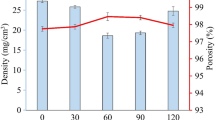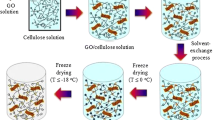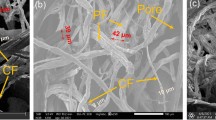Abstract
Cellulose aerogel (CA) isolated from tea stem wastes (TSW) is a good fire retardant and heat insulator, environmentally friendly, thermally stable and highly porous material with a network structure. These outstanding properties have attracted a huge interest in the materials world. In this study, firstly, following delignification and removing hemicellulose, pure raw cellulose was isolated using TSW, hydrogel form of cellulose was prepared by regeneration of cellulose solution, and then, the final product (CA) was produced via freeze-drying. The data results showed that the aerogel had a three dimensionally network structure. Moreover, it can be deduced that thermal durability of the studied CA could be effective because of its fire retardant and heat insulating property. In addition, the production process of CA is easily available at low cost and sustainable.








Similar content being viewed by others
References
Aegerter MA, Leventis N, Koebel MA (2011) Aerogels handbook. Advances in sol-gel derived materials and technologies. Springer, New York. https://doi.org/10.1007/978-1-4419-7589-8
Leppanen K, Andersson S, Torkkeli M, Knaapila M, Kotelnikova N, Serimaa R (2009) Structure of cellulose and microcrystalline cellulose from various wood species, cotton and flax studied by X-ray scattering. Cellulose 16(6):999–1015. https://doi.org/10.1007/s10570-009-9298-9
Postek MT, Vladar A, Dagata J, Farkas N, Ming B, Wagner R, Raman A, Moon RJ, Sabo R, Wegner TH, Beecher J (2011) Development of the metrology and imaging of cellulose nanocrystals. Meas Sci Technol. https://doi.org/10.1088/0957-0233/22/2/024005
Duong HM, Nguyen ST (2016) Nanocellulose aerogels as thermal insulation materials. In: Pacheco Torgal F, Buratti C, Kalaiselvam S, Granqvist C-G, Ivanov V (eds) Nano and biotech based materials for energy building efficiency. Springer, Cham, pp 411–427. https://doi.org/10.1007/978-3-319-27505-5_15
Liu J, Cheng F, Grenman H, Spoljaric S, Seppala J, Eriksson JE, Willfor S, Xu CL (2016) Development of nanocellulose scaffolds with tunable structures to support 3D cell culture. Carbohyd Polym 148:259–271. https://doi.org/10.1016/j.carbpol.2016.04.064
Shen XP, Shamshina JL, Berton P, Bandomir J, Wang H, Gurau G, Rogers RD (2016) Comparison of hydrogels prepared with ionic-liquid-isolated vs commercial chitin and cellulose. Acs Sustain Chem Eng 4(2):471–480. https://doi.org/10.1021/acssuschemeng.5b01400
Kwon GJ, Kim DY, Hwang JH, Kang JH (2014) Structural properties and adsorption capacity of holocellulose aerogels synthesized from an alkali hydroxide-urea solution. J Korean Phys Soc 64(10):1470–1473. https://doi.org/10.3938/jkps.64.1470
Wang ZG, Liu SL, Matsumoto Y, Kuga S (2012) Cellulose gel and aerogel from LiCl/DMSO solution. Cellulose 19(2):393–399. https://doi.org/10.1007/s10570-012-9651-2
Ahmadi M, Madadlou A, Sabouri AA (2015) Isolation of micro- and nano-crystalline cellulose particles and fabrication of crystalline particles-loaded whey protein cold-set gel. Food Chem 174:97–103. https://doi.org/10.1016/j.foodchem.2014.11.038
Awal A, Sain M, Chowdhury M (2011) Preparation of cellulose-based nano-composite fibers by electrospinning and understanding the effect of processing parameters. Compos Part B 42(5):1220–1225. https://doi.org/10.1016/j.compositesb.2011.02.011
Long LY, Weng YX, Wang YZ (2018) Cellulose aerogels: synthesis, applications, and prospects. Polymers-Basel 10(6):623
Seantier B, Bendahou D, Bendahou A, Grohens Y, Kaddami H (2016) Multi-scale cellulose based new bio-aerogel composites with thermal super-insulating and tunable mechanical properties. Carbohyd Polym 138:335–348. https://doi.org/10.1016/j.carbpol.2015.11.032
Kobayashi Y, Saito T, Isogai A (2014) Aerogels with 3D ordered nanofiber skeletons of liquid-crystalline nanocellulose derivatives as tough and transparent insulators. Angew Chem Int Ed 53(39):10394–10397. https://doi.org/10.1002/anie.201405123
Kaya M (2017) Super absorbent, light, and highly flame retardant cellulose-based aerogel crosslinked with citric acid. J Appl Polym Sci. https://doi.org/10.1002/App.45315
Beck-Candanedo S, Roman M, Gray DG (2005) Effect of reaction conditions on the properties and behavior of wood cellulose nanocrystal suspensions. Biomacromolecules 6(2):1048–1054. https://doi.org/10.1021/bm049300p
Krokida MK, Karathanos VT, Maroulis ZB (1998) Effect of freeze-drying conditions on shrinkage and porosity of dehydrated agricultural products. J Food Eng 35(4):369–380. https://doi.org/10.1016/S0260-8774(98)00031-4
Han YY, Zhang XX, Wu XD, Lu CH (2015) Flame retardant, heat insulating cellulose aerogels from waste cotton fabrics by in situ formation of magnesium hydroxide nanoparticles in cellulose gel nanostructures. Acs Sustain Chem Eng 3(8):1853–1859. https://doi.org/10.1021/acssuschemeng.5b00438
Nemoto J, Saito T, Isogai A (2015) Simple freeze-drying procedure for producing nanocellulose aerogel-containing, high-performance air filters. Acs Appl Mater Int 7(35):19809–19815
Jin H, Nishiyama Y, Wada M, Kuga S (2004) Nanofibrillar cellulose aerogels. Colloid Surf A 240(1–3):63–67. https://doi.org/10.1016/j.colsurfa.2004.03.007
Huang YJ, Zhou T, He S, Xiao H, Dai HM, Yuan BH, Chen XF, Yang XB (2019) Flame-retardant polyvinyl alcohol/cellulose nanofibers hybrid carbon aerogel by freeze drying with ultra-low phosphorus. Appl Surf Sci 497:143775
Mi HY, Jing X, Politowicz AL, Chen E, Huang HX, Turng LS (2018) Highly compressible ultra-light anisotropic cellulose/graphene aerogel fabricated by bidirectional freeze drying for selective oil absorption. Carbon 132:199–209
Zhang XX, Yu Y, Jiang ZH, Wang HK (2015) The effect of freezing speed and hydrogel concentration on the microstructure and compressive performance of bamboo-based cellulose aerogel. J Wood Sci 61(6):595–601
Poletto M, Ornaghi HL, Zattera AJ (2014) Native cellulose: structure, characterization and thermal properties. Materials 7(9):6105–6119. https://doi.org/10.3390/ma7096105
Zhang W, Zhang Y, Lu CH, Deng YL (2012) Aerogels from crosslinked cellulose nano/micro-fibrils and their fast shape recovery property in water. J Mater Chem 22(23):11642–11650
Zhang LN, Ruan D, Zhou JP (2001) Structure and properties of regenerated cellulose films prepared from cotton linters in NaOH/Urea aqueous solution. Ind Eng Chem Res 40(25):5923–5928
Kataoka Y, Kondo T (1998) FT-IR microscopic analysis of changing cellulose crystalline structure during wood cell wall formation. Macromolecules 31(3):760–764. https://doi.org/10.1021/ma970768c
Zhou ZH, Zhang XX, Lu CH, Lan LD, Yuan GP (2014) Polyaniline-decorated cellulose aerogel nanocomposite with strong interfacial adhesion and enhanced photocatalytic activity. RSC Adv 4(18):8966–8972
Xiao S, Gao R, Lu Y, Li J, Sun Q (2015) Fabrication and characterization of nanofibrillated cellulose and its aerogels from natural pine needles. Carbohyd Polym 119:202–209. https://doi.org/10.1016/j.carbpol.2014.11.041
Kumar P, Barrett DM, Delwiche MJ, Stroeve P (2009) Methods for pretreatment of lignocellulosic biomass for efficient hydrolysis and biofuel production. Ind Eng Chem Res 48(8):3713–3729. https://doi.org/10.1021/ie801542g
Zhang SQ, Wang J, Shen J, Deng ZS, Lai ZQ, Zhou B, Attia SM, Chen LY (1999) The investigation of the adsorption character of carbon aerogels. Nanostruct Mater 11(3):375–381. https://doi.org/10.1016/S0965-9773(99)00054-9
Zhang XT, Jing SS, Chen ZH, Zhong LX, Liu QZ, Peng XW, Sun RC (2017) Fabricating 3D hierarchical porous TiO2 and SiO2 with high specific surface area by using nanofibril-interconnected cellulose aerogel as a new biotemplate. Ind Crop Prod 109:790–802
Zhao HB, Zhou XC, Fu ZB, Mi R, Wang CY (2017) Freestanding monolithic Ni aerogel with large surface areas from cellulose aerogel templates. Mater Lett 196:296–299
Kandola BK, Horrocks AR, Price D, Coleman GV (1996) Flame-retardant treatments of cellulose and their influence on the mechanism of cellulose pyrolysis. J Macromol Sci R M C 36(4):721–794
Wu JW, Sung WF, Chu HS (1999) Thermal conductivity of polyurethane foams. Int J Heat Mass Tran 42(12):2211–2217
Gu JW, Zhang QY, Zhang JP, Wang WW (2010) Studies on the preparation of polystyrene thermal conductivity composites. Polym-Plast Technol 49(13):1385–1389
Golovanevskii VA (1993) Prediction of the thermal-conductivity of oriented fiberglass plastics. Mech Compos Mater 29(3):289–293
Flaifel MH, Ahmad SH, Hassan A, Bahri S, Tarawneh MA, Yu LJ (2013) Thermal conductivity and dynamic mechanical analysis of NiZn ferrite nanoparticles filled thermoplastic natural rubber nanocomposite. Compos Part B-Eng 52:334–339
Acknowledgements
The financial support by “Recep Tayyip Erdoğan University Scientific Research Project Council (Project No: FBA-2016-550)” is gratefully acknowledged.
Author information
Authors and Affiliations
Corresponding author
Ethics declarations
Conflict of interest
The authors declare that there is no conflict of interest regarding the publication of this paper.
Additional information
Publisher's Note
Springer Nature remains neutral with regard to jurisdictional claims in published maps and institutional affiliations.
Rights and permissions
About this article
Cite this article
Kaya, M., Tabak, A. Recycling of an Agricultural Bio-waste as a Novel Cellulose Aerogel: A Green Chemistry Study. J Polym Environ 28, 323–330 (2020). https://doi.org/10.1007/s10924-019-01609-6
Published:
Issue Date:
DOI: https://doi.org/10.1007/s10924-019-01609-6




